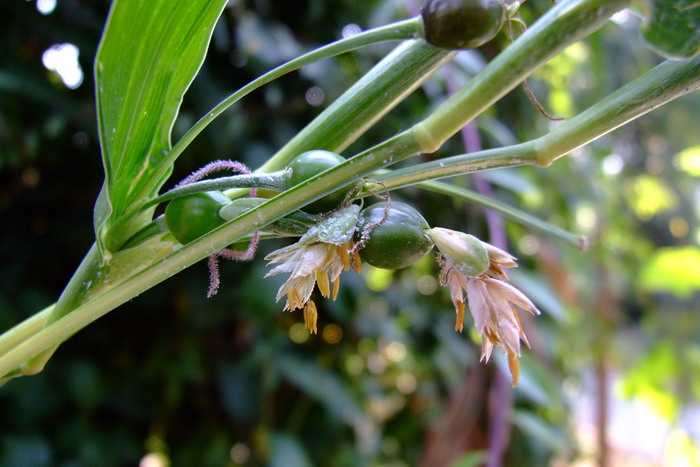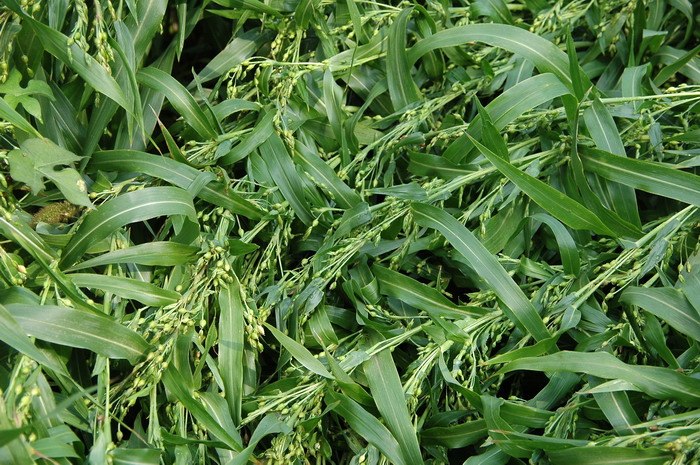薏苡 Coix lacryma-jobi
中文名(Chinese Name):薏苡
学名(Scientific Name):Coix lacryma-jobi L.
英文名(English Common Name):Job's tears
别名(Chinese Common Name):薏米
异名(Synonym):Coix lacryma-jobi var. maxima Makino Lithagrostis lacryma-jobi (L.) Gaertn. Coix lacryma L. Sphaerium lacryma (L.) Kuntze Coix lacryma-jobi var. novoguineensis Pilg. Coix ovata Stokes Coix pendula Salisb. Coix stigmatosa K.Koch & Bouché Coix pumila Roxb. Coix ouwehandii Koord. Coix palustris Koord. Coix agrestis var. maxima (Makino) Nakai
科属(Family & Genus):禾本科(Gramineae)薏苡属
形态特征(Description):一年生粗壮草本,须根黄白色,海绵质,直径约3毫米。秆直立丛生,高1-2米,具10多节,节多分枝。叶鞘短于其节间,无毛;叶舌干膜质,长约1毫米;叶片扁平宽大,开展,长10-40厘米,宽1.5-3厘米,基部圆形或近心形,中脉粗厚,在下面隆起,边缘粗糙,通常无毛。总状花序腋生成束,长4-10厘米,直立或下垂,具长梗。雌小穗位于花序之下部,外面包以骨质念珠状之总苞,总苞卵圆形,长7-10毫米,直径6-8毫米,珐琅质,坚硬,有光泽;第一颖卵圆形,顶端渐尖呈喙状,具10余脉,包围着第二颖及第一外稃;第二外稃短于颖,具3脉,第二内稃较小;雄蕊常退化;雌蕊具细长之柱头,从总苞之顶端伸出.颖果小,含淀粉少,常不饱满.雄小穗2-3对,着生于总状花序上部,长1-2厘米;无柄雄小穗长6-7毫米,第一颖草质,边缘内折成脊,具有不等宽之翼,顶端钝,具多数脉,第二颖舟形;外稃与内稃膜质;第一及第二小花常具雄蕊3枚,花药桔黄色,长4-5毫米;有柄雄小穗与无柄者相似,或较小而呈不同程度的退化。染色体2n=10(Rao, T. N. V., 1962);20(Koul A. K.,1965;Sarma, 1986)。花果期6-12月。
分布(Distribution):我国大部分地区有栽培或逸生,印度、缅甸、泰国、越南、马来西亚、印度尼西亚、菲律宾等也有。
用途(Use):本种为念佛穿珠用的菩提珠子,总苞坚硬,美观,工艺价值大。
引自中国植物志英文版FOC Vol. 22 Page 648, 649
Coix lacryma-jobi Linnaeus, Sp. Pl. 2: 972. 1753.
薏苡 yi yi | Poaceae | Coix
Annual. Culms erect, robust, 1–3 m tall, more than 10-noded, branched. Leaves cauline; leaf sheaths shorter than internodes, glabrous; leaf blades linear-lanceolate, usually glabrous, 10–40 × 1.5–7 cm, midvein stout, base subrounded or cordate, margins scabrous, apex acute; ligule 0.6–1.2 mm. Male raceme 1.5–4 cm, spikelets in pairs with terminal triad; utricle ovoid to cylindrical, usually bony, shiny, 7–11 × 6–10 mm, white, bluish or gray-brown, sometimes with apical beak. Male spikelets oblong-ovate, 6–9 mm; glumes many-veined, lower glume winged on keels, wings 0.4–0.8 mm wide, wing margin ciliolate; anthers 4–5 mm. Fl. and fr. Jun–Dec. 2n = 20.
Streams, marshy valleys, moist fields, by houses, often cultivated. Anhui, Fujian, Guangdong, Guangxi, Guizhou, Hainan, Hebei, Heilongjiang, Henan, Hubei, Hunan, Jiangsu, Jiangxi, Liaoning, Nei Mongol, Ningxia, Shaanxi, Shandong, Shanxi, Sichuan, Taiwan, Xinjiang, Yunnan, Zhejiang [Bhutan, India, Indonesia, Laos, Malaysia, Myanmar, Nepal, New Guinea, Philippines, Sri Lanka, Thailand, Vietnam].
This species is now widely cultivated in tropical and subtropical regions of the world (Job's Tears). There are many variants, of which the following are the most distinct.


 (责任编辑:徐晔春)
(责任编辑:徐晔春)
学名(Scientific Name):Coix lacryma-jobi L.
英文名(English Common Name):Job's tears
别名(Chinese Common Name):薏米
异名(Synonym):Coix lacryma-jobi var. maxima Makino Lithagrostis lacryma-jobi (L.) Gaertn. Coix lacryma L. Sphaerium lacryma (L.) Kuntze Coix lacryma-jobi var. novoguineensis Pilg. Coix ovata Stokes Coix pendula Salisb. Coix stigmatosa K.Koch & Bouché Coix pumila Roxb. Coix ouwehandii Koord. Coix palustris Koord. Coix agrestis var. maxima (Makino) Nakai
科属(Family & Genus):禾本科(Gramineae)薏苡属
形态特征(Description):一年生粗壮草本,须根黄白色,海绵质,直径约3毫米。秆直立丛生,高1-2米,具10多节,节多分枝。叶鞘短于其节间,无毛;叶舌干膜质,长约1毫米;叶片扁平宽大,开展,长10-40厘米,宽1.5-3厘米,基部圆形或近心形,中脉粗厚,在下面隆起,边缘粗糙,通常无毛。总状花序腋生成束,长4-10厘米,直立或下垂,具长梗。雌小穗位于花序之下部,外面包以骨质念珠状之总苞,总苞卵圆形,长7-10毫米,直径6-8毫米,珐琅质,坚硬,有光泽;第一颖卵圆形,顶端渐尖呈喙状,具10余脉,包围着第二颖及第一外稃;第二外稃短于颖,具3脉,第二内稃较小;雄蕊常退化;雌蕊具细长之柱头,从总苞之顶端伸出.颖果小,含淀粉少,常不饱满.雄小穗2-3对,着生于总状花序上部,长1-2厘米;无柄雄小穗长6-7毫米,第一颖草质,边缘内折成脊,具有不等宽之翼,顶端钝,具多数脉,第二颖舟形;外稃与内稃膜质;第一及第二小花常具雄蕊3枚,花药桔黄色,长4-5毫米;有柄雄小穗与无柄者相似,或较小而呈不同程度的退化。染色体2n=10(Rao, T. N. V., 1962);20(Koul A. K.,1965;Sarma, 1986)。花果期6-12月。
分布(Distribution):我国大部分地区有栽培或逸生,印度、缅甸、泰国、越南、马来西亚、印度尼西亚、菲律宾等也有。
用途(Use):本种为念佛穿珠用的菩提珠子,总苞坚硬,美观,工艺价值大。
引自中国植物志英文版FOC Vol. 22 Page 648, 649
Coix lacryma-jobi Linnaeus, Sp. Pl. 2: 972. 1753.
薏苡 yi yi | Poaceae | Coix
Annual. Culms erect, robust, 1–3 m tall, more than 10-noded, branched. Leaves cauline; leaf sheaths shorter than internodes, glabrous; leaf blades linear-lanceolate, usually glabrous, 10–40 × 1.5–7 cm, midvein stout, base subrounded or cordate, margins scabrous, apex acute; ligule 0.6–1.2 mm. Male raceme 1.5–4 cm, spikelets in pairs with terminal triad; utricle ovoid to cylindrical, usually bony, shiny, 7–11 × 6–10 mm, white, bluish or gray-brown, sometimes with apical beak. Male spikelets oblong-ovate, 6–9 mm; glumes many-veined, lower glume winged on keels, wings 0.4–0.8 mm wide, wing margin ciliolate; anthers 4–5 mm. Fl. and fr. Jun–Dec. 2n = 20.
Streams, marshy valleys, moist fields, by houses, often cultivated. Anhui, Fujian, Guangdong, Guangxi, Guizhou, Hainan, Hebei, Heilongjiang, Henan, Hubei, Hunan, Jiangsu, Jiangxi, Liaoning, Nei Mongol, Ningxia, Shaanxi, Shandong, Shanxi, Sichuan, Taiwan, Xinjiang, Yunnan, Zhejiang [Bhutan, India, Indonesia, Laos, Malaysia, Myanmar, Nepal, New Guinea, Philippines, Sri Lanka, Thailand, Vietnam].
This species is now widely cultivated in tropical and subtropical regions of the world (Job's Tears). There are many variants, of which the following are the most distinct.
踩一下[0]
下一篇:水稻Oryza sativa

顶一下[4]